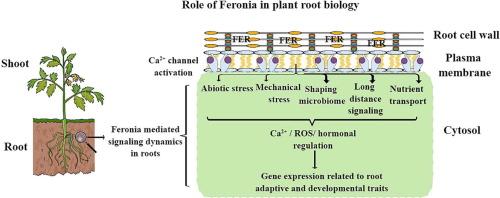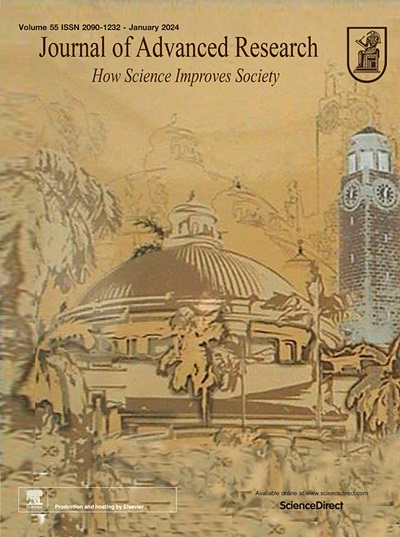A molecular perspective on the role of FERONIA in root growth, nutrient uptake, stress sensing and microbiome assembly
IF 11.4
1区 综合性期刊
Q1 MULTIDISCIPLINARY SCIENCES
引用次数: 0
Abstract
Background
Roots perform multifaceted functions in plants including the movement of nutrients and water, sensing stressors, shaping microbiome, and providing structural support. How roots perceive and respond above traits at the molecular level remains largely unknown. Although crop development has greatly advanced, most current efforts have concentrated on above-ground traits leaving significant knowledge gaps in root biology. Also, studying root system architecture (RSA) is more difficult due to its intricacy and the difficulties of observing them during plant life cycle. However, with the aid of high throughput phenotyping and genotyping tools many developmental and stress-mediated regulation of RSA has emerged in both model and crop plants leading to new insights in root biology. Our current understanding of upstream signaling events (cell wall, apoplast) in roots and how they are interconnected with downstream signaling cascades has largely been constrained by the fact that most research in plant systems concentrates on cytosolic signal transduction pathways while ignoring the early perception by cells’ exterior parts. In this regard, we discussed the role of FERONIA (FER) a cell wall receptor-like kinase (RLK) which acts as a sensor and a bridge between apoplast and cytosolic signaling pathways in root biology.Aim of the review
The goal of this study is to provide valuable insights into present understanding and future research perspectives on how FER regulates distinct root responses related to growth and adaptation.Key scientific concepts of review
In plants, FER is a unique RLK because it can act as a multitasking sensor regulate diverse growth, and adaptive traits. In this review, we mainly highlighted its role in root biology like how it modulates distinct root responses such as root development, sensing abiotic stressors, mechanical stimuli, nutrient transport, and shaping microbiome. Further, we provided an update on how FER controls root traits by involving RALF peptides, calcium, ROS and hormones. We also highlight number of outstanding questions in FER mediated root responses that warrant future investigation. We believe that FER can provide novels insights for the development of future climate resilient and high yielding crops based on the modified root system.

从分子角度看 FERONIA 在根系生长、养分吸收、压力感应和微生物组组装中的作用
背景根系在植物体内发挥着多方面的功能,包括养分和水分的移动、感知压力、塑造微生物群和提供结构支撑。根系如何在分子水平上感知和响应上述性状在很大程度上仍是未知数。虽然农作物的发展取得了巨大进步,但目前的大部分工作都集中在地上性状上,根系生物学方面的知识仍有很大差距。此外,由于根系结构(RSA)错综复杂,而且在植物生命周期中很难对其进行观察,因此研究根系结构较为困难。然而,借助高通量表型和基因分型工具,在模式植物和作物中出现了许多由发育和胁迫介导的根系结构调控,从而为根系生物学提供了新的见解。我们目前对根的上游信号事件(细胞壁、细胞外质)以及它们如何与下游信号级联相互联系的了解主要受限于这样一个事实,即植物系统中的大多数研究都集中于细胞质信号转导途径,而忽略了细胞外部的早期感知。在这方面,我们讨论了细胞壁受体样激酶(RLK)--FERONIA(FER)的作用,它在根生物学中充当传感器和细胞凋亡体与细胞质信号通路之间的桥梁。在这篇综述中,我们主要强调了它在根生物学中的作用,如它如何调节不同的根部反应,如根的发育、感知非生物胁迫、机械刺激、养分运输和塑造微生物组。此外,我们还介绍了 FER 如何通过 RALF 肽、钙、ROS 和激素控制根的性状。我们还强调了 FER 介导的根系反应中一些悬而未决的问题,这些问题值得在未来进行研究。我们相信,FER 可以为基于改良根系开发未来具有气候适应能力的高产作物提供新颖的见解。
本文章由计算机程序翻译,如有差异,请以英文原文为准。
求助全文
约1分钟内获得全文
求助全文
来源期刊

Journal of Advanced Research
Multidisciplinary-Multidisciplinary
CiteScore
21.60
自引率
0.90%
发文量
280
审稿时长
12 weeks
期刊介绍:
Journal of Advanced Research (J. Adv. Res.) is an applied/natural sciences, peer-reviewed journal that focuses on interdisciplinary research. The journal aims to contribute to applied research and knowledge worldwide through the publication of original and high-quality research articles in the fields of Medicine, Pharmaceutical Sciences, Dentistry, Physical Therapy, Veterinary Medicine, and Basic and Biological Sciences.
The following abstracting and indexing services cover the Journal of Advanced Research: PubMed/Medline, Essential Science Indicators, Web of Science, Scopus, PubMed Central, PubMed, Science Citation Index Expanded, Directory of Open Access Journals (DOAJ), and INSPEC.
 求助内容:
求助内容: 应助结果提醒方式:
应助结果提醒方式:


